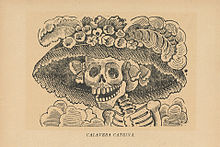
c. 1845
This triptych tells the story of the hero Ōyatarō Mitsukuni, who forces the evil Araimaru to the ground with his sword. By doing so, he drives out the giant skeleton spectre invoked by the sorceress Takiyasha-hime (on the left), and the enchanted palace Masakado collapses. Kuniyoshi’s masterful visual realization of the novel by Santō Kyōden (alias Kitao Masanobu!) already seems to anticipate the principles according to which images would be organized in modern manga.
F. Trikotin, La Tour de Peilz (November 1965)
Riese Collection #109
Taira Masakado was the rebellious third son of the Shōgun Taira no Yoshikado. In 939, after a lifetime of aggression and discontent, he finally declared himself shôgun, setting up a rival court in Kyōto. An expedition was sent out the following year and he was defeated and killed. According to legend, however, he left a daughter, Princess Takiyasha, to whom he had taught his magic and black arts, and who swore, upon her father’s death that she would destroy the ruling dynasty and be avenged. As she was preparing herself for this undertaking she was visited by a young warrior name Ōya Tarō Mitsukuni. Mitsukuni was loyal to the ruling clan, and had come to spy on Masakado’s descendents, but Takiyasha in her loneliness and fixity of purpose supposed that he had been sent in answer to her prayers to serve as an ally. To bind him in her service she made love to Mitsukuni, but all her blandishments were to no avail. When it became clear to her that he had no intention of helping her, that he was a spy and had discovered the secret of her plans for revenge, she realised that she must kill him, and summoning up all the magic arts at her command she tried. Mitsukuni remained resolute and undaunted and survived the ordeal. In this picture he is glaring fearlessly at a gigantic phantom skeleton which Takiyasha, a scroll of magic in her hands, as summoned forth. His sword is pinning down Araimaru, a surviving retainer of Masakado, perhaps now protecting his daughter. It was probably this very lack of fear, not disbelief, that rendered Takiyasha’s phantoms powerless, since all devils and monsters drink their power through our fear, and become, at last, insuperable. In showing Mitsukuni as a very young man, with his hair still tied behind in a pony tail, Kuniyoshi may have paid homage to the fearlessness and purity of youth, where an older man might have fallen to Takiyasha’s charms, or, failing that, become paralysed, and destroyed himself through fear.
Kuniyoshi’s immediate source was probably the kabuki play Yo ni Utō Sōma no Furugosho, a dramatisation of the Mitsukuni-Takiyasha story which was first performed in 1836, and was based in its turn on Utō Yasukata Chūgiden, a novel based in the life of Masakado by Santō Kyōden.
Reproduced in: Ingelheim catalogue, no. 95a.
Another impression is reproduced in Robinson, Kuniyoshi, pl. 43.
Kuniyoshi’s immediate source was probably the kabuki play Yo ni Utō Sōma no Furugosho, a dramatisation of the Mitsukuni-Takiyasha story which was first performed in 1836, and was based in its turn on Utō Yasukata Chūgiden, a novel based in the life of Masakado by Santō Kyōden.
Reproduced in: Ingelheim catalogue, no. 95a.
Another impression is reproduced in Robinson, Kuniyoshi, pl. 43.















.jpg)
.jpg)
.jpg)
.jpg)
.jpg)
.jpg)
.jpg)




















